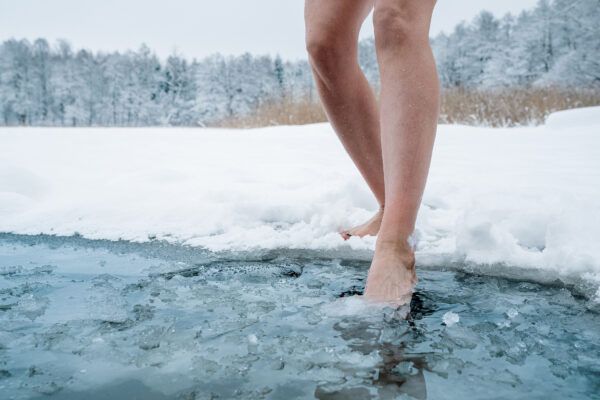Expert Tips to Keep Your Skin Healthy, Hydrated, and Glowing
By Jamie Bussin, featuring Vee Mistry
As Canadians, we pride ourselves on being able to handle the cold weather. We bundle up, brave the winds, and endure months of icy sidewalks and early sunsets. But while our spirits may be hardy, our skin doesn’t always fare as well. The cold, dry air outside combined with warm, forced air inside can wreak havoc on even the healthiest complexions.
To help us understand what’s really happening to our skin in winter — and what we can do about it — I spoke with Vee Mistry, a skincare expert who’s passionate about helping people care for their skin from the inside out, on Episode #221 of the Tonic Talk Show/Podcast. This is a digest of that conversation.
The Winter Skin Struggle
“The extreme cold outside and the warmth indoors — that instant climate change — can be really hard on the skin,” says Mistry. “It creates excessive dryness, dehydration, and even trauma.”
When the skin experiences that kind of stress, it can become compromised. The skin barrier starts to lose lipids and water, which are essential for keeping it soft and protected. The result can be flakiness, redness, sensitivity, and even inflammation. In some cases, that irritation can lead to congestion — those small bumps under the skin — or trigger flare-ups of rosacea.
This damage goes beyond surface dryness. “When the skin is in a state of trauma, it breaks down protein cells — specifically collagen and elastin — the scaffolding that gives skin its youthfulness and structure,” says Mistry.
Aging and Slower Renewal
Unfortunately, the effects of winter worsen with age. “As we get older, our ability to create new cells and repair damage slows down,” says Mistry. “Cell turnover just doesn’t happen as quickly as it did when we were in our twenties. That’s why our skin can start to look dull and lose its radiance.”
But there’s good news: there are practical steps we can take to restore hydration, improve resilience, and bring back that healthy glow.
Nourish From Within
While most of us think first about what we can apply to our skin, Mistry emphasizes that what’s happening inside the body is just as important.
“Skincare isn’t just about what you put on your face,” she says. “It’s about internal balance. You need to drink plenty of water, limit sugar, and eat a nutrient-rich diet.”
Mistry warns against glycation — a process where sugar molecules attach to proteins like collagen and elastin, breaking them down and causing the skin to lose its firmness. Reducing sweets, desserts, and even certain alcoholic beverages like wine and cocktails can make a noticeable difference.
“Supplementing your skincare is essential,” she adds. “Make sure your diet supports healthy skin — vitamins, antioxidants, and essential fatty acids all help rebuild from the inside out.”
Smart Skincare Choices
Once you’ve taken care of internal nourishment, it’s time to focus on topical care. Mistry recommends looking for ingredients that support hydration and regeneration.
“Hyaluronic acid is one of my favourites,” she says. “It can hold up to a thousand times its weight in water, which helps give skin that plump, juicy feel.”
She also highlights vitamin A (retinol) for stimulating collagen production, and collagen-based products to reinforce the skin’s natural support structure. Together, these ingredients help smooth fine lines and restore elasticity.
The Power of Exfoliation
Another important step, according to Mistry, is regular exfoliation. It encourages those newer, healthier skin cells to move toward the surface and it helps slough off dead skin cells that can make your complexion look dull.
The skin has three main layers: the hypodermis, dermis, and epidermis. The outermost layer — the stratum corneum — is where dead cells accumulate. By gently removing this buildup, products can penetrate more effectively, and your skin can breathe and glow.
For mature or sensitive skin, Mistry recommends chemical exfoliants over harsh scrubs. Lactic acid, glycolic acid, and alpha hydroxy acids (AHAs) all exfoliate in a controlled way. They work at different depths depending on their molecular structure, which makes them more effective and less damaging than physical scrubs.
Mistry also cautions against over-exfoliating or using aggressive tools. “People sometimes get too enthusiastic and end up causing more trauma than good,” she says. “You want to support your skin barrier, not strip it.”
The Benefits of Facial Massage
If exfoliation helps your skin look fresh, facial massage helps it look lifted and alive. “We have more than 40 muscles in our face, neck, and décolletage,” Mistry explains. “Just like the rest of our body, they need to move and stay active.”
Facial massage helps sculpt, lift, and contour the face — almost like a natural workout for your skin. As we age, everything slowly moves downward. Says Mistry,“Think of it like a push-up bra for your face — we’re just lifting things back where they belong.”
Even a few minutes of massage morning and night can boost circulation and oxygen flow, delivering nutrients to skin cells and encouraging rejuvenation.
Mistry’s golden rule? “Always move upwards and outwards,” she says. “Start from the neck and move toward the hairline. Never drag the skin down — gravity is already doing that for us.”
Cryotherapy: Cool Your Way to Radiance
Lastly, one of Mistry’s favourite tools for glowing skin is cryotherapy — the application of cold to calm, tighten, and refresh the skin.
“When you lower the skin’s temperature, it reduces inflammation and improves circulation,” she explains. “As your body warms back up, oxygen and nutrients rush to the area, creating a beautiful tightening effect.”
The Bottom Line
Winter may be tough on our skin, but with the right care — both inside and out — it doesn’t have to leave us dry, red, or dull. Staying hydrated, choosing nourishing foods, exfoliating gently, and incorporating facial massage or cryotherapy can keep your complexion healthy and glowing all year long.
So, as you reach for your scarf and moisturizer this winter, remember that caring for your skin is more than a seasonal chore — it’s an act of self-care that pays off in confidence and radiance.




